
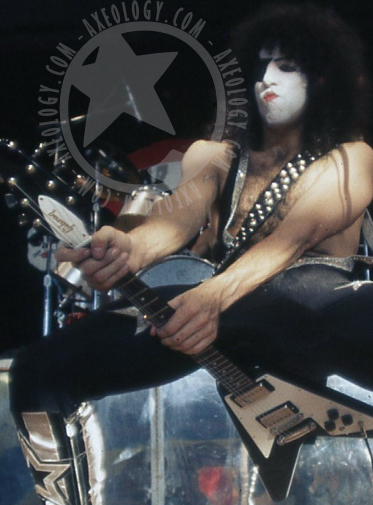

By now it should come as no surprise that Paul liked the Flying V. Part of the reason for this was probably the slight resurgance of the Flying V as a rock and blues guitar in the late 60's. After shipping a measly 98 Flying V's in 1958-59 the model was discontinued by Gibson and it was only after Albert King's use of a 1959 korina Flying V inspired Jimi Hendrix to get one, and an airline lost Dave Davies' Guild custom leading him to buy a 1958, that the Flying V really entered the mainstream. (Paul has mentioned Albert King's bound Flying V as the inspiration for his LoBue custom V. That Flying V, known as "Lucy" as inlayed on the headstock, was custom made for King by Dan Erlwine in the early 1970's.) Gibson re-issued the Flying V 1966-70 but sales were still less than stellar, in those 4 years Gibson shipped a measly 175 guitars to dealers. After a brief run of "Medallion" Flying V's in 1971, they had an actual medallion on the upper wing to commemorate the 1972 Olympic games, the Flying V again disappeared and only returned in 1975.
In the summer of 1975 KISS were still a struggling band. As a live act they were on the rise and although it seems as if neither the band nor their management had any real hopes of their recently completed live album proving a turning point it was nevertheless a reason to hit the road again. The Alive! Tour began on September 10 to coincide with the release of the album. For the tour Paul shows up with a new friend, a Gibson Flying V. (There is possibly an earlier shot from Albany, NY on August 9 that shows a Flying V in Paul's hands but it's a small and poor-quality picture that doesn't really betray any hints to the location.)
In the summer of 1975 KISS were still a struggling band. As a live act they were on the rise and although it seems as if neither the band nor their management had any real hopes of their recently completed live album proving a turning point it was nevertheless a reason to hit the road again. The Alive! Tour began on September 10 to coincide with the release of the album. For the tour Paul shows up with a new friend, a Gibson Flying V. (There is possibly an earlier shot from Albany, NY on August 9 that shows a Flying V in Paul's hands but it's a small and poor-quality picture that doesn't really betray any hints to the location.)


In Upper Derby, PA on October 3 there is no doubt that Paul is playing a Flying V and in Passaic, NJ the night after (see pic above) there's no doubt that it's a Gibson. For the photo shoot before the show in Cadillac, MI on October 9 Paul poses with this Flying V and shows us something that is most certainly not a stock 1975 Gibson Flying V. I do think it's a 1975 however and here's why. First of all the 1958-59 had the three controls arranged in a line. Plus, Gibson only built 98 of them. In 1975 a 1958 or '59 Gibson Flying V was almost as rare as it is today (although probably a lot less expensive). The 1966-69 reissue had the ridiculously long head. The 1971 Medallions, apart from the actual medallion on the upper wing and only being available in cherry, had the tuning posts a lot closer to the edge of the headstock than usual and Paul's looks to have a little more "wood to spare" comparatively speaking. However, this argument against the 1971 is the weakest as we shall see.
Whatever year this Gibson Flying V actually is, 1971 or 1975, it's been altered quite a bit. First, the simplest of the modifications are the control knobs. Both the 1971 and 1975 Flying V came with the so-called "witch-hat knobs" with a chrome top labeled either VOL or TONE but Paul's V here has the same type of knobs as were on the Midnight Special: clear lucite knobs with a black base and 1-10 in white. Second, neither the 1971 or '75 had pickup rings on the humbuckers and Paul has added black rings to his V. Third, the 1971 had Kluson or Gibson Deluxe double ring tulip-style tuners in pearl while the 1975 had aluminum Gibson Deluxe tulip-style tuners. Paul's V has tulip-style tuners but these are chrome. (And therein lies the rub of the "wood to spare" argument above - replacing the tuners could easily change the perception of how close to the edge the tuners were because the width of the bushings may not be the same.)
Whatever year this Gibson Flying V actually is, 1971 or 1975, it's been altered quite a bit. First, the simplest of the modifications are the control knobs. Both the 1971 and 1975 Flying V came with the so-called "witch-hat knobs" with a chrome top labeled either VOL or TONE but Paul's V here has the same type of knobs as were on the Midnight Special: clear lucite knobs with a black base and 1-10 in white. Second, neither the 1971 or '75 had pickup rings on the humbuckers and Paul has added black rings to his V. Third, the 1971 had Kluson or Gibson Deluxe double ring tulip-style tuners in pearl while the 1975 had aluminum Gibson Deluxe tulip-style tuners. Paul's V has tulip-style tuners but these are chrome. (And therein lies the rub of the "wood to spare" argument above - replacing the tuners could easily change the perception of how close to the edge the tuners were because the width of the bushings may not be the same.)

One thing that might settle this is the volute. Gibson added a volute, an added mass of wood where the neck meets the headstock designed to strengthen the joint, to the Flying V in 1971 and it was slightly more narrow and extended further down the neck than it later did on the 1975. Paul's V did have a volute, there's no question about that, but it's rarely shown in any detail and certainly not well enough to be able to assess what year it might be. In the end I'm going to call this a 1975 for the simple reason of availability: the 1971 Medallion Flying V was a limited run of 350 while Gibson produced 1,872 Flying V's in 1975.
This Flying V seems to have been the one that turns into his no. 1 over the next year-and-a-half. (He will eventually have two and although it's perfectly possible that he had two from the start it's impossible to tell until much later.) The first thing that happens to the new no. 1 is a pickup change. By November 1 in St. Louis, MO the chrome pickup covers have been removed and the bridge pickup has been replaced, probably with a creme DiMarzio (since that was Paul's usual M.O. at the time, in fact, it's quite a surprise it took so long for the change to happen).
This Flying V seems to have been the one that turns into his no. 1 over the next year-and-a-half. (He will eventually have two and although it's perfectly possible that he had two from the start it's impossible to tell until much later.) The first thing that happens to the new no. 1 is a pickup change. By November 1 in St. Louis, MO the chrome pickup covers have been removed and the bridge pickup has been replaced, probably with a creme DiMarzio (since that was Paul's usual M.O. at the time, in fact, it's quite a surprise it took so long for the change to happen).

It's perfectly possible that the pickup switch coincided with this next change but the picture evidence isn't there until we get to Toledo, OH on November 12. (Overall this is a great series of backstage shots as far as KISS' guitars go: it's the first real showing of Gene's LoBue with the P-bass pickup, the Epiphone Coronet is standing around awaiting its turn, and Paul shows us his new tuners.) Thanks to Paul kindly showing us the headstock we can see that the chrome tulip-style tuners are gone and in their place we find what looks like the classic Schaller M6.
After this the rest of 1975 is thankfully quiet as far as modifications go. The Flying V stays the same right up till the band close out an eventful years with a show in Uniondale, NY on December 31 (the highlight of which might have been the band meeting Linda Lovelace backstage).
After this the rest of 1975 is thankfully quiet as far as modifications go. The Flying V stays the same right up till the band close out an eventful years with a show in Uniondale, NY on December 31 (the highlight of which might have been the band meeting Linda Lovelace backstage).
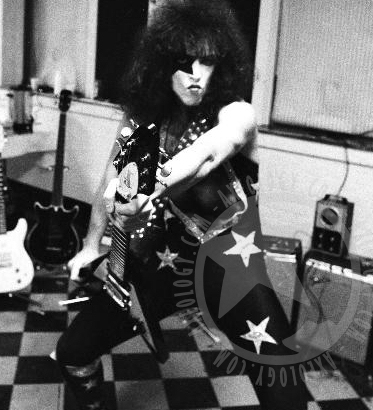
[Left] Backstage in Toledo. The Flying V has a fresh set of Schaller M6 tuners.


The start of 1976 sees more of the same from Paul and his no. 1 Flying V. From late 1975 to early 1976 he had the Gibson Les Paul Custom as a backup but the Flying V is the go-to guitar. It can be seen both nights from Detroit, MI in January (consult your KISSology vol. 1) and in plenty of pics. Come February 23 in Los Angeles, CA things start to change though. As can be seen in the shot on the right the no. 1 stays the same. This pic, and this bizarre backstage shot, show that although Paul had the knobs changed he retained the pointer inserts that indicate the setting. But as the picture below makes clear Paul debuts a new guitar at this show. Although the picture is small and lacking in detail it's obvious that this Flying V doesn't have a white pickguard. Thankfully this same guitar appears again the next night and we can see that this Flying V has a mirror pickguard and a new mirror truss rod cover on the headstock. Unfortunately that's about as good as look as we get.
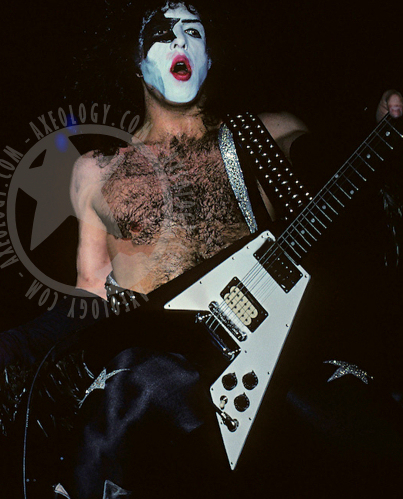

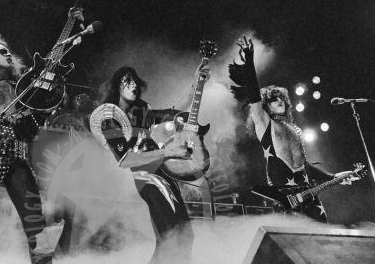

After these two showings the new mirror-clad Flying V seems to get a rest from the spotlight (or at least from being caught on camera) and the action focuses once again on the no. 1 Flying V. A picture from about a month later in Lakeland, FL on March 20 shows the no. 1 looking exactly like itself but just a few days later in Philadelphia, PA on March 24 all manner of modifications have been made. First of all the neck pickup is just gone and so is one of the knobs. It looks as if the electronics have been simplified and the guitar has gotten a new pickguard but that's not the case. As this pic clearly shows the hole left from the neck pickup has simply been covered by some kind of tape or a piece of plastic. So even though the electronics have indeed been simplified, this is the original pickguard in a new guise. Less apparent in the pics from March 24 is how much the control layout of the guitar has actually changed. To appreciate that we have to look at the comparison pic below.
First the obvious, it's missing a knob. Since there's no longer a neck pickup the "lost" knob is the neck pickups volume. The 1971 and 1975 models had a curious knob arrangement. Rather than have the two volume controls closest to the player's hand (like on modern Flying V's) it had the master tone control closest to the bridge and the two volume knobs below it which made the only move Paul really ever made, adjusting the volume of the bridge pickup, a little cumbersome. With only one pickups the 3-way selector switch becomes obsolete and for some reason the output jack has been moved to the location of the switch (also seen here).
First the obvious, it's missing a knob. Since there's no longer a neck pickup the "lost" knob is the neck pickups volume. The 1971 and 1975 models had a curious knob arrangement. Rather than have the two volume controls closest to the player's hand (like on modern Flying V's) it had the master tone control closest to the bridge and the two volume knobs below it which made the only move Paul really ever made, adjusting the volume of the bridge pickup, a little cumbersome. With only one pickups the 3-way selector switch becomes obsolete and for some reason the output jack has been moved to the location of the switch (also seen here).
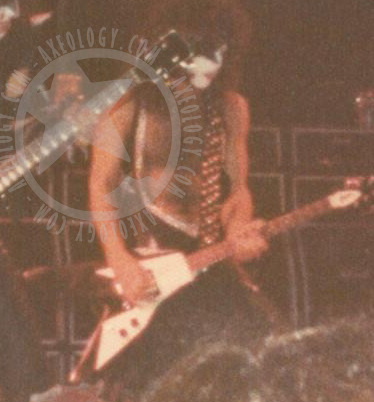

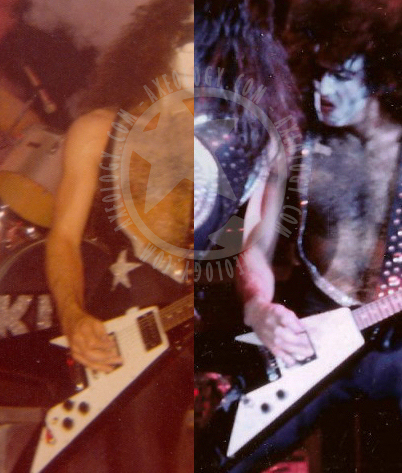


After a shockingly brief break from touring the band re-appeared for the Destroyer tour, albeit in their Dressed to kill/Alive! costumes, and did a couple of shows in the eastern states and Canada. On April 23 in Kitchener, Ontario both the modified no. 1 and the mirror Flying V get in on the action but none of the available pics show them with any clarity. Come April 26 in Toronto, Ontario the mirror-pickguard Flying V finally reveals itself and here the controls are once again different. (There is a pic from April 24 that shows a Flying V with what appears to be this same control layout but it's too blurry to really say for certain. Without the pic from Toronto and subsequent shows I'm not sure I would see the same thing in that pic.)
The output jack is here in its original place unlike on the modified white-pickguard V. What is now the single volume knob is in the "top" volume position closest to the playing position of the right hand while the tone knob has migrated to the position originally occupied by the 3-way switch. The transformation also includes replacing the stock ABR-1 bridge with a Schaller harmonica bridge, a move that would become standard on his guitars until he gets the PS10 (see the Gibson Explorer and the Ibanez Destroyer).
The output jack is here in its original place unlike on the modified white-pickguard V. What is now the single volume knob is in the "top" volume position closest to the playing position of the right hand while the tone knob has migrated to the position originally occupied by the 3-way switch. The transformation also includes replacing the stock ABR-1 bridge with a Schaller harmonica bridge, a move that would become standard on his guitars until he gets the PS10 (see the Gibson Explorer and the Ibanez Destroyer).
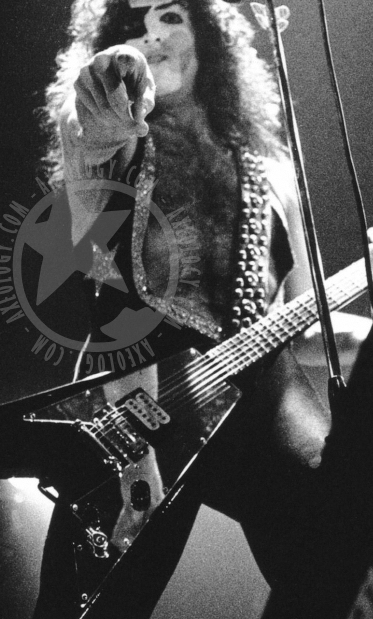

So why change the control layout? KISS's music in the live setting has never been about subtle tonal changes. If anything the band tried to beat its early audiences into submission with pure volume, even from their first showcase for Casablanca, and along with their visual appearance the live show was more about pummeling the senses rather than any kind of intricacy. The control layout on Paul's 1975 Flying V had the knob he used the least (if at all) pretty much obstructing his reach for the volume knob that he did use which was hardly ideal. Allowing for easy access to the volume knob and maximizing the space between it and the tone knob makes sense. The removal of the neck pickup and the 3-way switch served the same purpose, to minimize the number of things that can go wrong. Paul probably never used the neck pickup anyway. Check any good closeup of Paul playing the no. 1 Flying V in the fall of 1975 or the early part of 1976: it is always in the down position. He's only using the bridge pickup.
It's hard to make any kind of case for a nice, linear progression when it comes to the modifications of the Gibson Flying V since we can't say for sure whether or not the mirror pickguard V took on this final shape immediately or if it too went through a few trial runs like the white pickguard V. The picture evidence unfortunately tells us little. But, to play devil's advocate, it seems odd to change the bridge only on one guitar, especially since Paul had played guitars with the Schaller harmonica before so he knew it well and didn't really have to "try it out".
This mirror pickguard version of the Gibson Flying V is the guitar that launched a thousand shows (or close to it). After the brief domestic and Canadian run the band undertook a quick three-week tour of Europe and for those shows it's all about the "new" no. 1. The replacement Firebird I was along for the ride but for the vast majority of European shows, at least judging by the available pictures, the mirror pickguard Flying V is the undisputed no. 1, a position it was to hold for well over a year.
It's hard to make any kind of case for a nice, linear progression when it comes to the modifications of the Gibson Flying V since we can't say for sure whether or not the mirror pickguard V took on this final shape immediately or if it too went through a few trial runs like the white pickguard V. The picture evidence unfortunately tells us little. But, to play devil's advocate, it seems odd to change the bridge only on one guitar, especially since Paul had played guitars with the Schaller harmonica before so he knew it well and didn't really have to "try it out".
This mirror pickguard version of the Gibson Flying V is the guitar that launched a thousand shows (or close to it). After the brief domestic and Canadian run the band undertook a quick three-week tour of Europe and for those shows it's all about the "new" no. 1. The replacement Firebird I was along for the ride but for the vast majority of European shows, at least judging by the available pictures, the mirror pickguard Flying V is the undisputed no. 1, a position it was to hold for well over a year.
[Right] A game of musical chairs with the controls of the 1975 Flying V.
[Above] The Gibson Flying V enters the picture. Though far from stock, this is about as close to it as the Flying V would get.
With their newfound success with Alive! and a new, hopefully career-altering album to promote, KISS undertook a couple of photo shoots in their new Destroyer costumes. For the full day of mostly outdoor shooting on June 24 Paul is nice enough to show us the no. 1 Flying V looking much as it did in the pic above and in the many pictures from the European tour. Come the start of the Spirit of '76 Tour it's all about the Flying V. The pic on the right is from Toledo, OH on July 31 and here appears a cinch in the armour, there's a small hairline crack in the pickguard extending from the output jack. Since it's a mirror the crack is most visible when seen at a slight angle, in concert photos that usually means shot from below because of the location of the photo pit, and in head-on shots it is almost impossible to see in most lighting conditions. The consistent placement, orientation and length of this defect, however, eliminates the possibility of it being a reflection of some sort. (This collection of images show the crack at various times over the course of the tour. I've taken the liberty of circling the defect and also including a pic, farthest on the right, from the Winter Tour in November.)
Paul brought two nearly identical Flying V's with him on tour, the only distinguishing feature between the two being the lack of a pickup ring on the no. 2 as the backstage picture from Houston, TX on August 13 below shows, and a small hook on the no. 1. Based on the pictures I've had the fortune of seeing, and the few availble videos from the Spirit of '76 Tour, the backup saw very little action. It didn't really get a chance to shine until the Paul Lynde Halloween Special taping on October 19 and 20.
Paul brought two nearly identical Flying V's with him on tour, the only distinguishing feature between the two being the lack of a pickup ring on the no. 2 as the backstage picture from Houston, TX on August 13 below shows, and a small hook on the no. 1. Based on the pictures I've had the fortune of seeing, and the few availble videos from the Spirit of '76 Tour, the backup saw very little action. It didn't really get a chance to shine until the Paul Lynde Halloween Special taping on October 19 and 20.
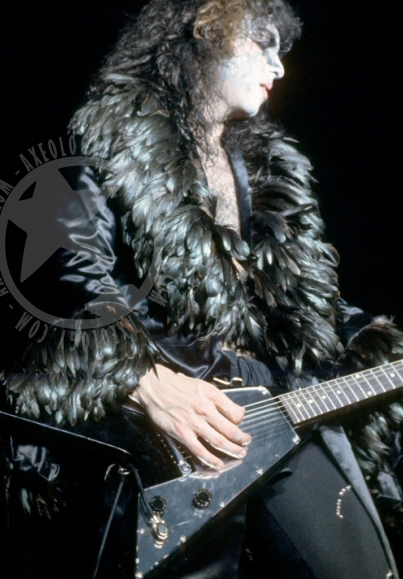

Come the Winter Tour of 1976-77 the Flying V is still no. 1. By now it's been joined by the Gibson Explorer in the backup position but there is still a second Flying V in the ranks as we shall see later on. Based on the pic on the left there is the possibility that the hairline crack pickguard has been switched for a new one. I for one have a really hard time seeing any kind of defect in the picture from Lakeland, FL on December 12.
Roughly around this time Paul began an off-stage hobby. "When we were on tour in America on the Rock And Roll Over tour, I got bored. I just decided to cover one of my black Gibson Vs with rhinestones." (Guitars that Rule the World in Metal Edge presents KISS Alive 1996) "What happened was I got bored, and every night after the show I would glue rhinestones on this guitar. I just thought it would be cool to have a rhinestone guitar! That rhinestone guitar was me and a bunch of Dukko's cement!" (Vintage Guitar, March 1997)
The first time the rhinestone V shows up is in New Haven, CT on December 18 but by then the guitar is already half-covered (looking more or less like the pic below) so it's a good bet he started it a few days earlier. A pic from Syracuse, NY two days earlier shows a non-bedazzled V but fails to distunguish between no. 1 and no. 2 so it's hard to tell when the rhinestone experiment "officially" begins. All we can say for certain is that some time between December 12 and 18 Paul decides that a crotch full of rhinestones isn't enough, he needs a guitar to match.
The work was obviously done in spurts rather than on any daily basis as the Paul quote above says because in Fayetteville, NC on December 27 the guitar is still only half-covered.
Roughly around this time Paul began an off-stage hobby. "When we were on tour in America on the Rock And Roll Over tour, I got bored. I just decided to cover one of my black Gibson Vs with rhinestones." (Guitars that Rule the World in Metal Edge presents KISS Alive 1996) "What happened was I got bored, and every night after the show I would glue rhinestones on this guitar. I just thought it would be cool to have a rhinestone guitar! That rhinestone guitar was me and a bunch of Dukko's cement!" (Vintage Guitar, March 1997)
The first time the rhinestone V shows up is in New Haven, CT on December 18 but by then the guitar is already half-covered (looking more or less like the pic below) so it's a good bet he started it a few days earlier. A pic from Syracuse, NY two days earlier shows a non-bedazzled V but fails to distunguish between no. 1 and no. 2 so it's hard to tell when the rhinestone experiment "officially" begins. All we can say for certain is that some time between December 12 and 18 Paul decides that a crotch full of rhinestones isn't enough, he needs a guitar to match.
The work was obviously done in spurts rather than on any daily basis as the Paul quote above says because in Fayetteville, NC on December 27 the guitar is still only half-covered.
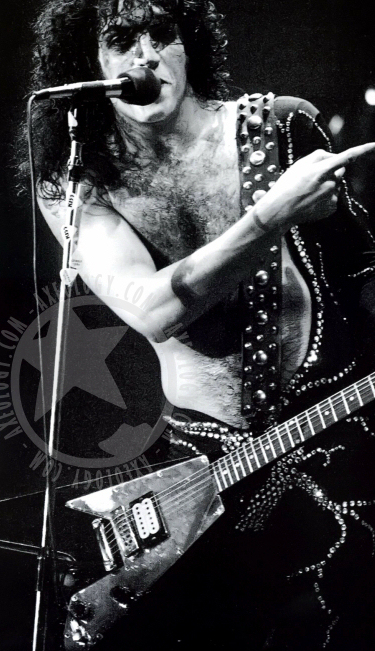

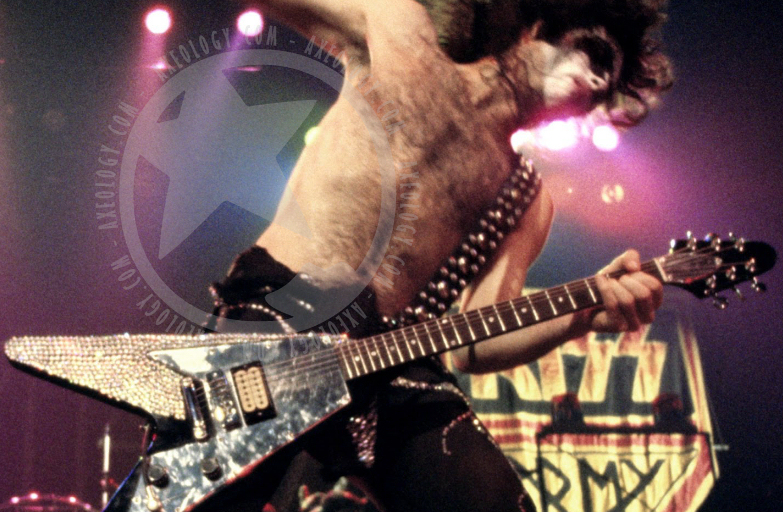


[Above] The no. 1 Flying V, hook ermoved and possibly with a new pickguard, gets ready for yet another change. Paul mentioned in 1997 (Vintage Guitar) that he thought this was a '73 Flying V. Gibson only shipped a grand total of two (2) Flying V's in 1973 and both were Medallions. Simply put, Paul was mistaken.
[Right] "The Rhinestone V looked very cool on stage, it was pretty dazzling." (Guitars that Rule the World in Metal Edge presents KISS Alive 1996) Paul half-way through his Dukko's Cement and a ridiculous amount of rhinestones. How anyone could consider this a remedy for boredom I'll never understand...
But even if the tedious work of putting rhinestones on a guitar was done in spurts, it was done quickly. By January 6 when the band invaded Tulsa, OK the work was done. Note that the area right under the stop tailpiece and the section between the tailpiece and the pickguard is still the original black meaning that it was never considered important enough to justify removing that part to "finish the job". Considering that the band's strings were changed on a regular basis one can only conclude that the approach here was the same as with the re-finished Firebird I, if it looks good from a few rows out then it's good enough.
The Tula, OK show is also the first real look at the no. 2 Flying V, an instrument which, missing pickup ring aside, appears to have been fairly indistinguishable from the no. 1 until the rhinestone project began. Between the two of them, and the bound-for-capo-duty Explorer, these guitars carried the load all the way to Japan. As mentioned in the short section on Paul's use of Greco guitars during the 1977 trip to Japan he shows up with a unidentifiable white Flying V for those shows. It is for all intents and purposes a perfect copy of his "standard" Flying V at the time - mirror pickguard, single humbucker, the control layout, the Schaller harmonica bridge - the only difference being that it's white. The obvious assumption is that it, too, is a Gibson that was tried briefly and then discarded (or perhaps used in order to be able to distinguish photographs from the Japanese shows, a practice the band would use from time to time with makeup and items of clothing). Pending further evidence I've decided to call that white Flying V a Greco in part because it's such an anomaly and, to be perfectly honest, just to have an opinion.
Both the mysterious white Flying V and the dazzling Rhinestone V feature prominently in the show from Tokyo on April 2.
The Tula, OK show is also the first real look at the no. 2 Flying V, an instrument which, missing pickup ring aside, appears to have been fairly indistinguishable from the no. 1 until the rhinestone project began. Between the two of them, and the bound-for-capo-duty Explorer, these guitars carried the load all the way to Japan. As mentioned in the short section on Paul's use of Greco guitars during the 1977 trip to Japan he shows up with a unidentifiable white Flying V for those shows. It is for all intents and purposes a perfect copy of his "standard" Flying V at the time - mirror pickguard, single humbucker, the control layout, the Schaller harmonica bridge - the only difference being that it's white. The obvious assumption is that it, too, is a Gibson that was tried briefly and then discarded (or perhaps used in order to be able to distinguish photographs from the Japanese shows, a practice the band would use from time to time with makeup and items of clothing). Pending further evidence I've decided to call that white Flying V a Greco in part because it's such an anomaly and, to be perfectly honest, just to have an opinion.
Both the mysterious white Flying V and the dazzling Rhinestone V feature prominently in the show from Tokyo on April 2.
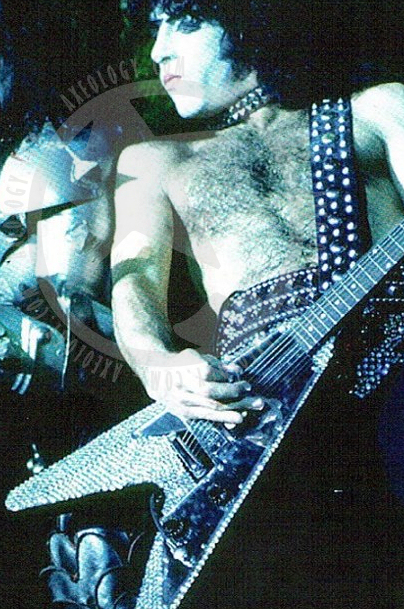

When it came time to bring Love Gun to the road on the Can-Am Tour the Flying V's were once again the main guitars but these were a new pair. The Rhinestone V is suddenly conspicuously absent. For one reason or another it was retired from stage use and put into storage where it stayed until it was stolen some time in the very early 90's. "It was stolen out of our warehouse 5 or 6 years ago [from 1996]. One day I saw it, I came back the next time, opened the case and it was gone." (Guitars that Rule the World in Metal Edge presents KISS Alive 1996) As can be seen from this backstage shot of the guitar lineup at the time Paul brought two Gibson Flying V's and the Gibson Explorer on the road with him. Although not visible in this pic a shot of the same lineup but taken from another angle reveals that the two 1977 V's are different much like the no. 1 and no. 2 were during the Spirit of '76 Tour, one is missing the pickup ring. Considering the pictures from the tour I will assume that the one with a pickup ring is, once again, the no. 1.
There are pics from opening night in Halifax, Nova Scotia that shows the no. 1 Flying V but I've chosen this pic from July 16 in Kitchener, Ontario to bring up an annoying detail (one which I mentioned in Gene's section as well): the guitar isn't plugged in. At least there's no cord coming from the output jack. This is a common theme in all the pics from the Can-Am tour, more specifically, Gene and Paul has nothing coming out of the output jack while Ace actually does. As mentioned in KISS Alive Forever the band began using Vega wireless systems (more accurately the Schaffer-Vega Diversity System) for this tour but even this system, at least as it's been pictured, requires a standard 1/4" plug. Nevertheless, Gene and Paul never seem to be plugged in. Two pictures will suffice to demonstrate. This pic from Edmonton, Alberta on July 27 gives a clear view of the cables running from the microphones but the guitars show nothing, not even a transmitter pack anywhere on the strap (which is the common way to have a wireless system). And this pic from a few days later in Calgary, Alberta show the band mid-song and we see both Gene and Paul with nothing coming from their output jacks while Ace very clearly is plugged in.
There are pics from opening night in Halifax, Nova Scotia that shows the no. 1 Flying V but I've chosen this pic from July 16 in Kitchener, Ontario to bring up an annoying detail (one which I mentioned in Gene's section as well): the guitar isn't plugged in. At least there's no cord coming from the output jack. This is a common theme in all the pics from the Can-Am tour, more specifically, Gene and Paul has nothing coming out of the output jack while Ace actually does. As mentioned in KISS Alive Forever the band began using Vega wireless systems (more accurately the Schaffer-Vega Diversity System) for this tour but even this system, at least as it's been pictured, requires a standard 1/4" plug. Nevertheless, Gene and Paul never seem to be plugged in. Two pictures will suffice to demonstrate. This pic from Edmonton, Alberta on July 27 gives a clear view of the cables running from the microphones but the guitars show nothing, not even a transmitter pack anywhere on the strap (which is the common way to have a wireless system). And this pic from a few days later in Calgary, Alberta show the band mid-song and we see both Gene and Paul with nothing coming from their output jacks while Ace very clearly is plugged in.


[Above] "One of the strangest things to happen to us was that we were the first band to go wireless. When we first started using them, they were tremendous for us because we no longer had to dance around each other to untangle wires. But the other side of it was that people thought we weren't really playing." (Musician's Friend 2013)
The only logical explanation seems to be that Gene's Spector and Paul's new Flying V's had built-in wireless transmitters. The Gibson doubleneck and the Explorer were both plugged in (as was Ace's Les Pauls) and when the PS10 arrives in August it is also sporting a lead from the output jack. But the V's remain unplugged.
When the Alive II Tour starts in November the second prototype PS10 is the new darling and the V's are relegated to backup duty. The first pic on the right shows the 1977 no. 2 Flying V in use for Makin' love in Madison, WI on December 3. Note the use of a capo, the lack of a pickup ring, and the blood on Paul's head which is from being hit in the head with a bottle. Below is a shot from one of the shows in New York, NY a few days later. This time it's the 1977 no. 1 Flying V that carries the capo as evidenced by the pickup ring.
When the Alive II Tour starts in November the second prototype PS10 is the new darling and the V's are relegated to backup duty. The first pic on the right shows the 1977 no. 2 Flying V in use for Makin' love in Madison, WI on December 3. Note the use of a capo, the lack of a pickup ring, and the blood on Paul's head which is from being hit in the head with a bottle. Below is a shot from one of the shows in New York, NY a few days later. This time it's the 1977 no. 1 Flying V that carries the capo as evidenced by the pickup ring.


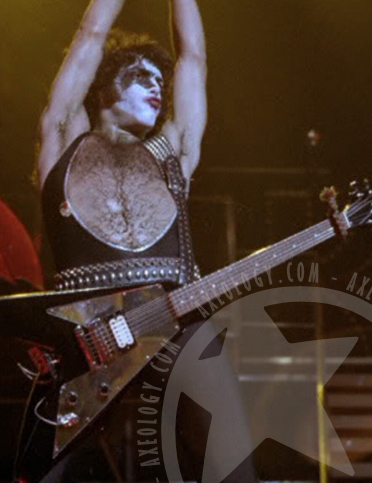

[Right] Rock n' roll warrior at work, slight blood loss is to be expected. Paul and the 1977 no. 2 Flying V in Madison.
[Left] 1977 Flying V no. 1 at Madison Square Garden. I'm sensing there might have been a choreographed moment or two during the 1977 KISS shows.
Be sure to compare this pic on the left with the pic from Kitchener above. Here the cable runing from the output jack is hard to miss and the wireless unit is clearly visible between the wings of the Flying V. In the Kitchener pic all we see is a lonely and unoccupied output jack.

Not one to change horses midstream Paul relied on the Flying V's as backup for the rest of the Alive II Tour, mostly on capo duty for Makin' love as the pic here shows, but after that they were summarily retired. There would be other V's in the years to come but they'd be different brands.
One mirror pickguard Gibson Flying V was part of the museum setup for the convention tour in 1995. It was described as being the "only remaining" of the original Flying V's and having been used during the Alive! and Destroyer tours.
Prologue: For the Reunion in 1996 Paul had Gibson build him a throwback Flying V meant to mimic the mirror pickguard Flying V of the glory days of the 70's. This Gibson Custom Shop Flying V had a single humbucker without pickup ring, a single volume knob, and a standard ABR-1 bridge/tailpiece. It was used mainly for Strutter and could be seen as lot 1165 in the Butterfields Auction.
One mirror pickguard Gibson Flying V was part of the museum setup for the convention tour in 1995. It was described as being the "only remaining" of the original Flying V's and having been used during the Alive! and Destroyer tours.
Prologue: For the Reunion in 1996 Paul had Gibson build him a throwback Flying V meant to mimic the mirror pickguard Flying V of the glory days of the 70's. This Gibson Custom Shop Flying V had a single humbucker without pickup ring, a single volume knob, and a standard ABR-1 bridge/tailpiece. It was used mainly for Strutter and could be seen as lot 1165 in the Butterfields Auction.

